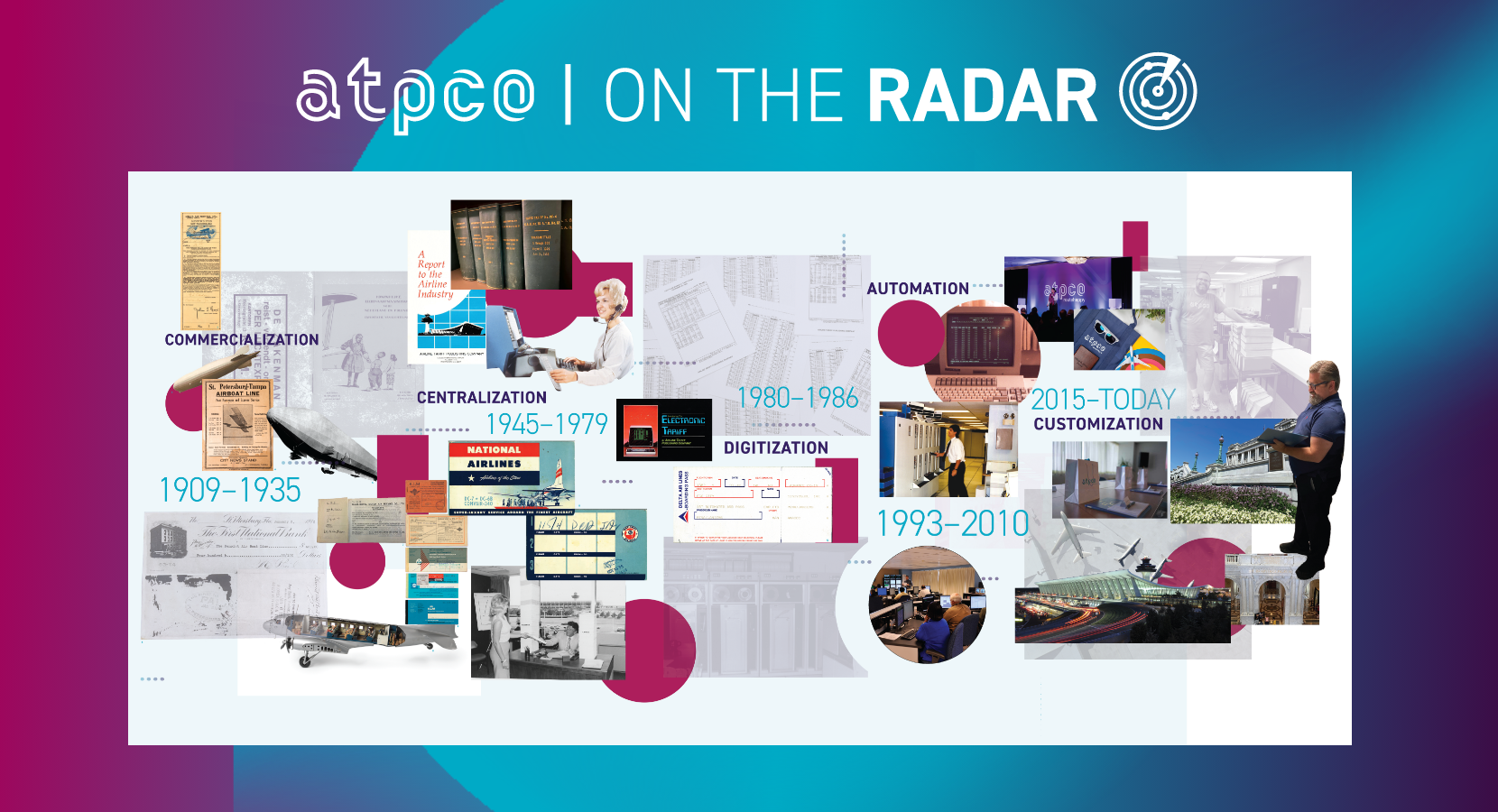
On paper, ATPCO’s origination story begins in the mid-1940s. In context of air travel history, however, ATPCO’s story begins with the advent of commercial aviation, when people opted to fly as an alternative to rail or boat travel, when passengers were transported for a fee, and when airlines were required to account for the airline fares and tariffs associated with each passenger’s ticket.
On 7 September 2022, we donated more than 1,500 books chronicling tariff, rule, routing, and other information dating back to 1943 to the Library of Congress. While these books give life to the history of airline retailing, they don’t include the history of ATPCO’s influence in helping commercial aviation take flight.

Early passenger air travel: First came altitude, then the need for speed
Aviation geeks know that the lead-up to commercial aviation began with the hunger for exploring higher altitudes. Early aviators met the need in the late 1700s when manned hydrogen balloons first launched in France. Steerable (dirigible) balloons arrived in 1901 followed by airships that increased interest in passenger air travel and fueled the need for speed. The first sustained, powered flight was in 1903. Six years later, the German-based airship company DELAG produced an airship (dirigible balloon) that was capable of controlled powered flight. DELAG transported more than 34,000 passengers during its time. To promote air travel, only 10,000 passengers were required to pay the ticket agent, Hamburg-Amerika steamship line.
DELAG was the world’s first airline, but what was the first airline-issued fare?
One hundred and nine years ago on 1 January 1914, 3,000 people witnessed the world's first fixed wing scheduled airline, St. Petersburg–Tampa Airboat Line, take flight. The sole passenger was former mayor of St. Petersburg Abram C. Pheil, whose fare was determined by auction: USD 400 (USD 11,200 today). The flight between St. Petersburg and Tampa only lasted 23 minutes. However, when scheduled flight services were introduced, so was the need to expand distance.
Going the distance: The beginnings of today’s passenger airline industry
As awe-inspiring and convenient as air travel was, it was several decades before passenger air travel really took off. Commercial aviation was sustained by government services (namely mail shipping), cargo, and military advances. It was not until the 1930s that passenger travel became commonplace and even then, use was limited by aircraft size as well as affordability. For example, the first passenger jetliners could only hold 36 to 44 people, and a round-trip, transcontinental ticket cost about USD 260 in 2020 dollars.
The idiom, “build the plane while flying it” very much describes the trajectory of commercial aviation. Aircraft manufacturers, airports, airlines, and airfares all began to proliferate as the support for the new primary means for travel within and between continents. By the 1940s, layers of government rules and regulations were applied to aviation, and airlines needed help centralizing the process of compiling fares for government review.
Increasing volume: Moving from tariff pages to millions of fares
In 1945, the Air Traffic Conference of America established a 20-person tariff department to manage and file domestic fares with the US government, adding cargo in 1958. In 1965, Airline Tariff Publishers, Inc. was established when the Air Traffic Conference's Tariff Department divested from the Air Transport Association of America (ATA). The latter was renamed ATPCO in 1975.
Passenger air travel became more popular, and after the United States deregulated it in 1978, a more complex infrastructure offered more options for airlines to compete in regional and global markets. Passenger air travel growth spurred ATPCO to pivot from manually filing 100 passenger and cargo tariff pages to daily clearing millions of changes electronically.
Increasing volumes and newly available technology led to innovation—a story that sounds familiar today.
Two periods of change helped to advance commercial aviation: Digitization and automation. During the 1980s and 1990s, ATPCO digitized the information filed on paper tariffs, automating manual processes, and enabling electronic connectivity for industry airfares. By 1986, the first Automated Ticket and Boarding Pass (ATB) was produced by Delta Air Lines, the oldest US carrier still in operation.
ATPCO produced innovative solutions like Fare By Rule to cascade fare updates more quickly. By the mid-2000s, ATPCO automated service fee processing, helping airlines more effectively recover unprecedented fuel and security costs. Meanwhile, airplanes were outfitted with more seats to carry more people for short and long hauls and airports added runways and remodeled airports to account for the uptick in air traffic.
Centralization, digitization, and automation help all industry players handle the volume of data that ATPCO processes and distributes today. ATPCO’s database holds more than 300 million fares and processes 13.4 million fare changes a day.
Accounting for time: Collaborating for faster innovation
Passenger air travel experienced the shocking results of the pandemic and responded by finding ways to improve. On the airfare front, ATPCO deployed innovative solutions and expertise to help the air travel industry recover. In 2021, ATPCO moved data and processing to the cloud to increase reliability, drive innovation that advances modern airline retailing, and reduce technical debt.
History teaches us that collaboration is essential. ATPCO fosters relationships that benefit all air travel industry players by ensuring consistent data built on 60 years of fare history.
For passengers, air travel should remain a safe, seamless experience that furthers the wonderment of discovering new places, people, and cultures. This was some of the impetus for early aviators taking to the skies and it still inspires us today.
Once flying under the radar while supporting the industry, ATPCO is now the foundation of modern airline retailing, and our role includes driving innovation, reducing complexity, and delivering network efficiencies to the airline ecosystem.
Peruse our Library of Congress catalog here, and learn about ATPCO solutions here.


